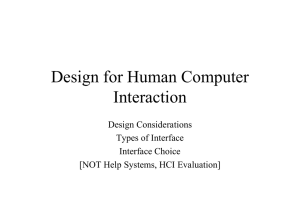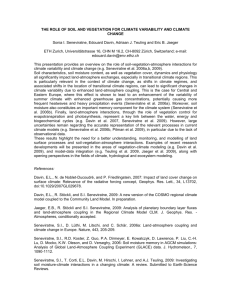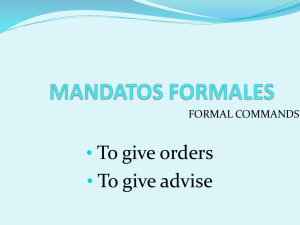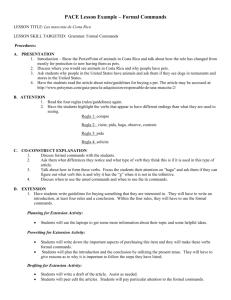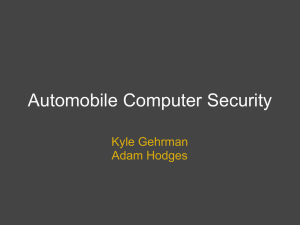6.870 Final Project Proposal
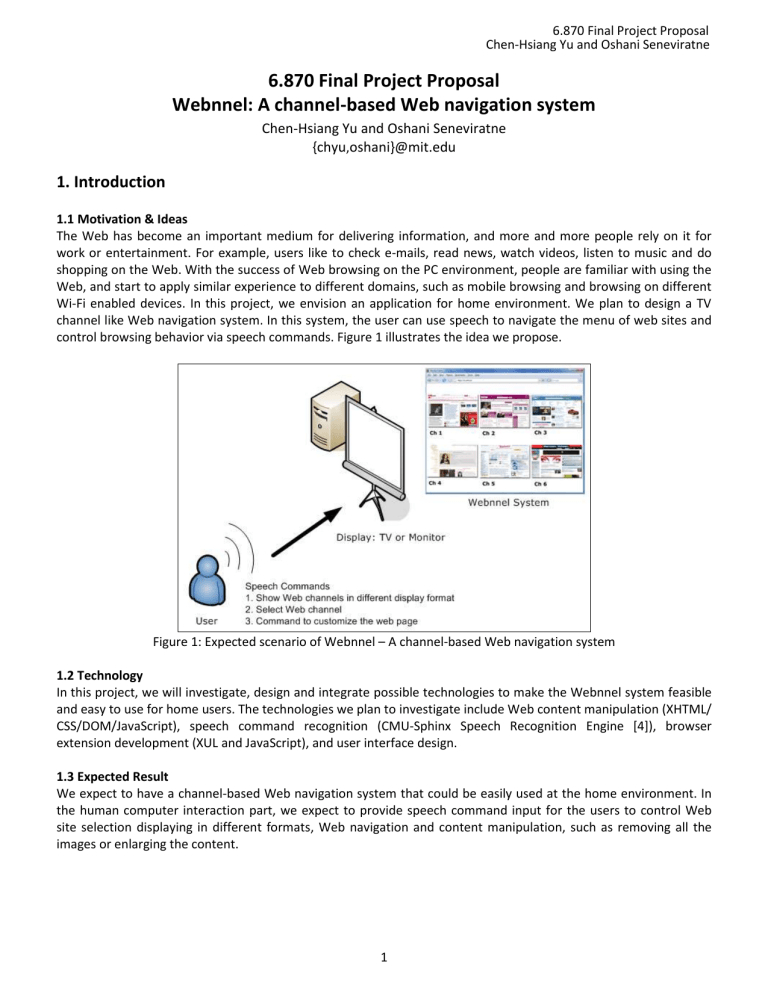
6.870 Final Project Proposal
Chen-Hsiang Yu and Oshani Seneviratne
6.870 Final Project Proposal
Webnnel: A channel-based Web navigation system
Chen-Hsiang Yu and Oshani Seneviratne
{chyu
,
oshani}@mit.edu
1. Introduction
1.1 Motivation & Ideas
The Web has become an important medium for delivering information, and more and more people rely on it for work or entertainment. For example, users like to check e-mails, read news, watch videos, listen to music and do shopping on the Web. With the success of Web browsing on the PC environment, people are familiar with using the
Web, and start to apply similar experience to different domains, such as mobile browsing and browsing on different
Wi-Fi enabled devices. In this project, we envision an application for home environment. We plan to design a TV channel like Web navigation system. In this system, the user can use speech to navigate the menu of web sites and control browsing behavior via speech commands. Figure 1 illustrates the idea we propose.
Figure 1: Expected scenario of Webnnel – A channel-based Web navigation system
1.2 Technology
In this project, we will investigate, design and integrate possible technologies to make the Webnnel system feasible and easy to use for home users. The technologies we plan to investigate include Web content manipulation (XHTML/
CSS/DOM/JavaScript), speech command recognition (CMU-Sphinx Speech Recognition Engine [4]), browser extension development (XUL and JavaScript), and user interface design.
1.3 Expected Result
We expect to have a channel-based Web navigation system that could be easily used at the home environment. In the human computer interaction part, we expect to provide speech command input for the users to control Web site selection displaying in different formats, Web navigation and content manipulation, such as removing all the images or enlarging the content.
1
6.870 Final Project Proposal
Chen-Hsiang Yu and Oshani Seneviratne
2. Related Work
2.1 UI and Content Access
Information display with TV channel format can be seen on some applications. Youtube uses frame list and flash animation to display the video clips. Joost [6] and Mogulus [8] use grid-based arrangement to display live TVs clips with multiple small screens. Even in the mobile device, Avot mV [1] uses similar display to provide video search. The idea of TV channel format presenting web sites is inspired by these applications, because we think it could save users’ time from typing in the URL address and provide more natural interaction and better Web browsing experience. However, to the best of our knowledge, we have not seen a similar system proposing an idea to display web sites as TV channels for the users to access frequently used web sites in a home environment.
To the Web content access, programmers can write JavaScript programs, which are embedded into HTML or XHTML web pages, to access web content dynamically. Chickenfoot [3] and Greasemonkey [5] are two web scripting frameworks that allow users to write scripts to customize the Web pages. Accessmonkey [2] is another script framework that allows multiple users, including web users, web developers and web researchers, to collaboratively write the scripts to enhance web page accessibility. Unfortunately, all of them do not provide interface for user to customize the web page by using natural interaction, such as speech or gesture.
2.2 Speech invoked content access
Speech invoked web content access is suitable for people with disabilities (especially people with dysfunctional hand motor-abilities), workers who need to access information in a hands-off manner to improve their productivity or simply the general user who wishes to have a much more natural interaction in accessing web pages with spoken commands. Microsoft Windows Vista Speech Recognition system [7] provides a platform for users to control
Windows applications. This supports dictation of documents and emails in mainstream applications, voice commands to start and switch between applications, control the operating system, and even fill out forms on the Web.
However, it does not have much flexibility in Web browsing and Web content manipulation.
3. Plan of Implementation
The Webnnel system architecture contains four components: (1) Content Manipulation Module (CMM); (2) Channel
Aggregation and Presentation (CAP); (3) Command Abstraction Interface (CAP); and (4) Speech Command Extraction
(SCE). We plan to integrate these four parts as a Firefox browser extension to demonstrate our idea. The whole system architecture is illustrated as Figure 2.
Figure 2: Webnnel system architecture
2
6.870 Final Project Proposal
Chen-Hsiang Yu and Oshani Seneviratne
Content Manipulation Module (CMM)
Define functions for a specific purpose, such as image detection and content access, for CAI.
Define functions for CAP to render content, such as web site snapshots or displaying with different formats.
Channel Aggregation and Presentation (CAP)
Rendering web site snapshots and providing appropriate UI supports.
Command Abstraction Interface (CAI)
Define high level APIs for SCE to use to satisfy users’ commands.
Speech Command Extraction (SCE)
Speech recognition and command extraction.
4. Speech Command Categories
Generally speaking, we have about 20 speech commands in 3 different categories. All the pre-defined speech commands and their categories are organized as Table 1.
Table 1: Defined speech commands and categories
Category Speech Command
Webnnel
Grid Mode
Frame Mode
Go to Webnnel main menu
Purpose
Display web sites in grid mode display
Display web sites in frame list mode display
Navigation
Channel X
Back
Next
Up
Down
Indicate Webnnel to go to selected web site. X is the number
Go to previous page if it is available
Go to next page if it is available
Scroll up the current viewing page
Content Access
Macros
Audio Command
Undo
Clean Page
Click XXX
Remove Image
My e-mail
Logout
My news
Yahoo
CNN
One clap
Two clap
Scroll down the current viewing page
Only “Clean Page” and “Remove Image” will undo. Otherwise, all will execute “Back” commands.
Detect possible annoying contents and shrink them
Click XXX link.
Remove all images on the page
Go to my G-mail account and show the email
Logout the G-mail account
Go to my predefined news page
Go to Yahoo! Home page
Go to CNN Home page
Go to Webnnel main menu
Go to homepage
We hope to build a language model consisting of the above speech commands to perform the corresponding command and control tasks. The speech commands from the user will be matched against the words and sentences given in the corpus of this language model in real time to perform the recognition.
3
6.870 Final Project Proposal
Chen-Hsiang Yu and Oshani Seneviratne
5. Timeline
The following Gantt chart shows the tentative timeline we have allocated for this project.
6. Collaboration
The Webnnel project is collaborated by Chen-Hsiang Yu and Oshani Seneviratne. We have divided our project into several tasks and each one of us will focus on specific tasks mentioned below.
Chen-Hsiang Yu:
Web content manipulation (CAI and CMM)
UI design (CAP)
Extension Development
User Study
Report Write-up
Oshani Seneviratne:
Speech recognition and extraction (SCE)
Extension Development
User Study
Report Write-up
Currently, we use Eclipse with SVN and Google Code online version control (http://code.google.com/p/webnnel/) to manage and synchronize our documents (such as this proposal), references, images and project source codes.
6. References
[1] Avot mV, http://www.avotmedia.com/
[2] Bigham, J. P., and Ladner, R. E. Accessmonkey: a collaborative scripting framework for web users and developers.
In W4A '07, ACM Press, pp. 25-34, 2007.
[3] Bolin, M., Webber, M., Rha, P., Wilson, T. and Miller, R.C. Automation and customization of rendered web pages,
Proceedings of the 18th annual ACM symposium on User interface software and technology, October 23-26,
2005.
[4] CMU-Sphinx Speech Recognition Engine, http://cmusphinx.sourceforge.net/html/cmusphinx.php
[5] Greasemonkey, https://addons.mozilla.org/en-US/firefox/addon/748
[6] Joost, http://www.joost.com/
[7] Microsoft Windows Vista Speech Recognition system http://www.microsoft.com/enable/products/windowsvista/speech.aspx
4
6.870 Final Project Proposal
Chen-Hsiang Yu and Oshani Seneviratne
[8] Mogulus, http://www.mogulus.com/
[9] Petrie, H., Hamilton, F. and King, N. Tension, what tension? Website accessibility and visual design. Proceedings
of the 2004 international cross-disciplinaryworkshop on Web accessibility (W4A), pp. 13-18, 2004.
[10] Richards, J. and Hanson, V. Web accessibility: a broader view. Proceedings of the 13th international conference
on World Wide Web, pp. 72-79, 2004.
5
